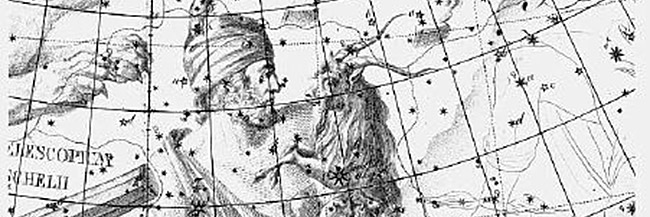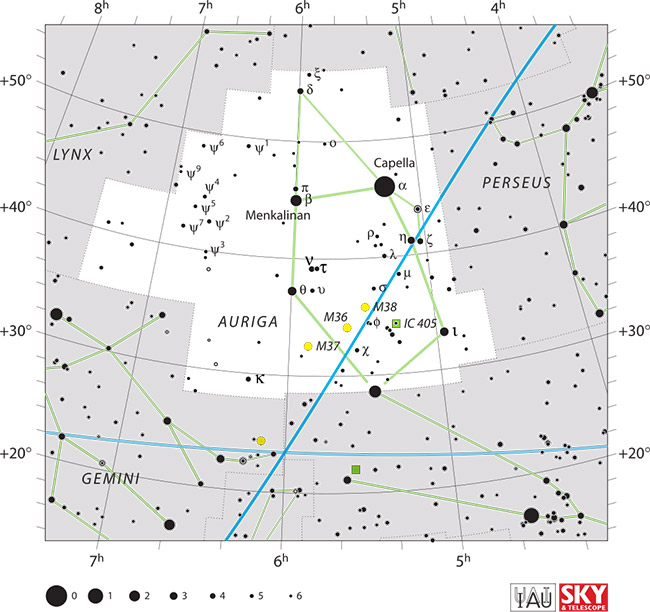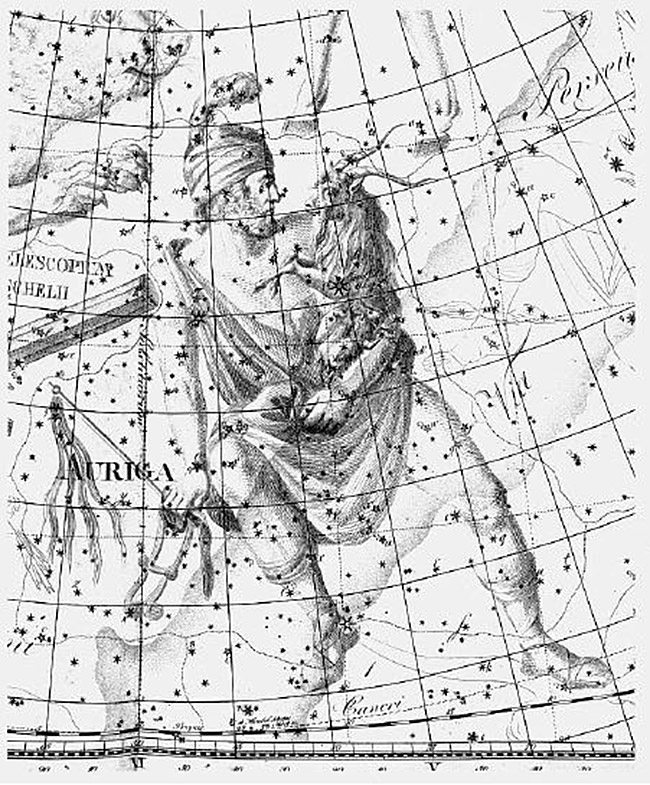Auriga – Constellation Facts

Auriga is the 21st biggest constellation in size and covers 657 square degrees. It can be viewed in the first quadrant of the Northern hemisphere and lies specifically at latitudes between +90° and -40°. Like some of the other constellations, in the 2nd century Auriga was first catalogued by Ptolemy, who was a Greek astronomer.
Constellation Characteristics
Auriga’s major stars form a pattern similar to the pointed helmet worn by a charioteer and for this reason it gets its name from the Latin meaning for charioteer. Auriga neighbors with the constellations of Camelopardalis, Gemini, Lynx, Perseus and Taurus. In addition, it is also the point in the night sky that lies opposite of the Milky Way galaxy center.

IAU and Sky & Telescope magazine (Roger Sinnott & Rick Fienberg), CC BY 3.0, via Wikimedia Commons
By IAU and Sky & Telescope magazine (Roger Sinnott & Rick Fienberg) CC BY 3.0, via Wikimedia CommonsPlanetary Systems
Auriga is home to five fascinating deep sky objects including three Messiers and two nebula. Check them out;
- Messier 36 (M36, NGC 1960): this open cluster contains around 60 stars and is estimated to be about 25 million years old. It has many B2-type stars that shine very brightly. M36 is situated 4,100 light-years away.
- Messier 37 (M37, NGC 2099): sitting from 3,600 to 4,700 light-years in distance, this open cluster contains about 500 stars, 150 of those shining brighter than magnitude 12.5 and with many red giants. It is also thought to be about 300 million years old.
- Messier 38 (M38, NGC 1912): around 220 million years-old, this open cluster’s brightest stars form an “oblique cross” or the letter Pi. Its most brilliant star shines at magnitude 7.9 and is 900 times brighter than the Sun.
- The Flaming Star Nebula (IC 405): this beauty lies 1,500 light-years from Earth and is considered an emission/reflection nebula.
- IC 410: this is an emission nebula that lies 2,200 light-years in distance.
Main Stars
The constellation Auriga contains nine significant stars. Read on to discover their amazing qualities.
- Capella (Alpha Aurigae) is the brightest star in Auriga (which will be discussed later in detail).
- Menkalinan (Beta Aurigae) comes from the Arabic phrase mankib ðī-l-‘inān, meaning “shoulder of the rein-holder.” It’s a triple star system with two white A-type subgiants shining the brightest and a red dwarf as the third component.
- Mahasim (Theta Aurigae) this star is sometimes call “Bogardus.” Its name is derived from the Arabic word for “wrist.” This is a double star with a Alpha-2 Canum Venaticorum type variable as its main component. It is located 173 light-years from Earth.
- Kabdhilinan (Hassaleh) ~ (Iota Aurigae) this orange K-type bright giant gets its name from the Arabic phrase meaning, “the ankle of the rein holder.” It is situated 512 light-years away.
- Almaaz (Epsilon Aurigae) deriving its name from the Arabic word for (billy) goat, this eclipsing binary star is made up of two components; F0 class supergiant and a single B-class star inside of a disk.
- Haedus II (Eta Aurigae) this star represent one of the kids of the goat held by the Charioteer. It is situated about 219 light-years from us and is considered to be a blue-white B-type main sequence dwarf.
- Sadatoni (Haedus) ~ (Zeta Aurigae) this eclipsing binary star is made up of a red supergiant and a B8-type companion. Its name is derived from the Arabic phrase meaning, “second arm” – it symbolizes the second goat held by the Charioteer.
- Prijipati (Delta Aurigae) this binary star is located 140 light-years away and is composed of an orange K-type giant. It derives its name from Indian astronomy which means, “the Lord of Creation.”
- AE Aurigae is in comparison to other stars, the one moving at a very high velocity and for this reason it’s considered a “runaway” star. In addition, AE Aurigae was thought to be the result of a collision between two binary star groups.

Auriga carrying the goat and kids, seen on Chart V of the Uranographia of Johann Bode (1801)
Auriga carrying the goat and kids, seen on Chart V of the Uranographia ofJohann Bode (1801)
Most Shining Star
Out of all the stars that make up the Auriga constellation none shine brighter than Capella. In fact, it is the sixth brightest star in the night sky. It is made up of two binary star pairs; two bright G-type giants and two cool red dwarfs. Capella symbolizes the Charioteer’s left shoulder or the goat he is carrying and also the goat that suckled Zeus (Amalthea).
Mythology & History
Auriga is steeped in mythology and although they do differ in the stories, the one common denominator throughout them all is the Charioteer. It’s odd that the constellation of Auriga is shown with a Charioteer holding the reins of the chariot in one hand and a goat and its kids in the other; however, none of the myths involve goats.
The most common legend is associated with the King of Athens (Erichthonius) who was the son of the fire god Hephaestus. He was taught many skills by the goddess Athena and was credited for being the first man to train four horses to pull a chariot.
Another myth revolves around the lame god, Hephaestus. He was thought to have built a chariot so he could travel wherever and whenever he wanted.
Auriga is a fascinating constellation, so the next time you are gazing into the night sky be sure to search out this intriguing figuration of stars.
